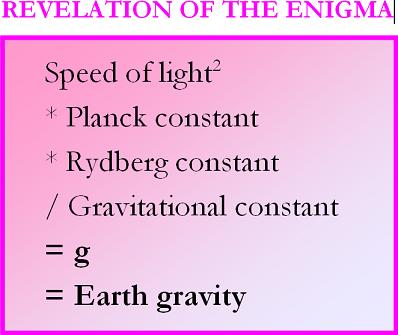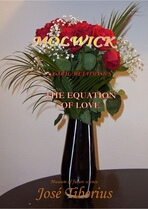3.b.3. Fundamental physical constants
As anticipated in the previous section on the Gravity Riddle, here is an analytical description related to the fundamental constants.
Let us divide it into the following parts where appears the Universal Gravitational constant G.
The Riddle of Gravity and its units
The physics constant G is present in the riddle of Gravity, together with the Rydberg, Planck, and speed of light constants.
 ♦
♦g = c² * h * R / G = 9,79383
It determines the gravity on the Earth’s surface (self-invited variable) from the following physical constants:
c = speed of light = 2,99792458 * 108 (m/s)
h = Planck’s constant = 6,6260693 * 10-34 ( J s)
Which comes from the Planck equation: E = h f
Where E is the energy and f the frequency or inverse of the wavelength concerning its speed
RH = Rydberg's constant = 2π² me Z² e4 / h³c= 1,0976776534 * 107 (1/m)
Where:
π is the number Pi
me: electron mass
Z: atomic number
e: electron charge
h: Planck's constant
c: speed of light
G = Universal Gravitation constant = 6,67266 * 10-11 (m² N / kg²)
Let us remember that the formula for gravity g is traditionally defined by:
g = G M / r² = 9,79838 (m/s²)
When:
M = mass of the Earth = 5,9737 * 1024 (kg)
r = radius of the Earth = 6,37814 * 106 (m)Note that the value of g at the Earth's surface changes from 9.78049 for 0º at the Equator to 9.83327 for 90º at the Pole.
The quantitative relationship between physical constants and the variable g is a relevant issue because, in addition to the problem of the units, the value of the physical constants mentioned cannot be that constant since, of the two components in the equality of the riddle, one of them contains exclusively physical constants. In contrast, the other part, the result of the operation or equivalence, is a decidedly variable quantity that depends in turn on two variables (M and r) that have little to do with the indicated constants.
Well, well thought out, for humans, M and r could be somewhat fixed or constant at least until the space age of the second half of the last century, just when General Relativity received a substantial boost almost 50 years after its formalization.
Taking into account that g on the surface of the Moon is one-sixth of the Earth’s gravity, one or more of the four physical constants involved, c, h, R, and G, are not as constant as they appear.
The relationship between the mass and charge of the electron with the mass and radius of the Earth
Constant G is in the Law of Universal Gravity by Isaac Newton, where the acceleration of gravity or force per mass unit is:
g = G M / r² = 9,79838 (m/s²)
Equating the formula of the Law of Universal Gravitation with that of the Riddle of Gravity [1], we will obtain:
[2] G M / r² = c² * h * R * N / G
Solving for the Rydberg constant R, we will have:
R = (G²/ c²) (1/N h ) M / r²
That is, the Rydberg constant R depends on the gravitational constant G, the speed of light c, the Planck constant h, the mass of the Earth M that generates the gravitational field, and the specific spatial reference r. Besides, the Rydberg constant R depends, among other things, on the mass and the charge of the electron, so it is possible to study the complex relationships between both ways of determining.
Such analysis could help to understand the adjustments in the dimensions of this physical constant and perhaps others, making unnecessary the artificial variable N. In addition, it could explain part of the effects of gravity without the need to relativize time, as does the Theory of General Relativity.
Congruence with the Equation of Love
The Equation of Love, despite its name and philosophical origin, has a mix nature of metaphysics and science since it can derive from Newton’s equation of gravity by substituting mass for its value in the equation of Einstein, E = m c² –original of Olinto de Pretto.
g = G M / r²
E = m c² ==> M=E/ c²
g = E G/r² c² = E G (t² / e4)
gravity = Energy * Love
Equation of love 
Returning to the Riddle of Gravity [1], there are two groups with the physical constants, the first one formed by c h R, whose dimensions are those of energy and, the second, by N c/G, corresponding to the Equation of Love.
In other words, the Riddle of Gravity follows the same conceptual equalities commented when speaking about gravity as a relationship between energy and love.
gravity = Energy * Love
g = c h R * N c/G
m/ s² = kg (m/ s²) m * (1/kg m)Molwick as a unit of Love
Note that N c/G is equal to a Molwick in both values and dimensions, that is, the unit of love defined in the Reflections on Love section.
1 Molwick = 1 Mw = 4,49285 * 10+18 (1/kg m)
As they are adjustments between masses and radii, they do not incorporate any units for those of the adjusted equation, that is, the Equation of Love: (1 / kg m)
The adjustments are strange since, on the one hand, they involve an equivalent mass of the electromagnetic energy of the photon emitted by the hydrogen atom and Earth’s mass; on the other hand, the change in a radius equal to the space traveled by the light in one second to the radius of the Earth.
Another approximation to the Equation of Love from the Riddle of Gravity is in [2] by dividing c² into c²/t², where c is the space traveled by light in one second, changing its side and multiplying both sides of the equation by (r/c)² we will have::
M G² t²/c4 = h * R * N * (r/c)²
Now, knowing that the Equation of Love is:
L = G t² / e4 = 1 amorcito = G/c4 = 8,26069 * 10-45 (1/kg m)
We will have to:
M A G = h * R * N * (r/c)²
L = (h/G) * (N R/M) * (r/c)²
Or, solving for R:
R = L * (G / N h) * M / (r/c)²
The Rydberg constant is back as a function of the mass and Earth’s radius, the definition of Love, G, h, and c.
In short, the Gigachron experiment or Gravity Riddle shows the existing relation between gravity and the basic configuration of energy. Together with Global Aether, this relation places us directly in the heart of the Global Physics, whose most popular aspects will be that time is not relative and space neither curves nor stretch.
* * *
